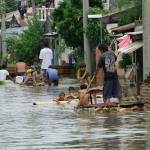Typhoon Season Brings Deadly Diseases to Asia
Typhoon season is in full swing in Southeast Asia, bringing with it destruction and misery that stays well after the storms have passed.
Hundreds of people are killed every year at this time of the year from flooding, landslides and deadly diseases. This year's casualty numbers are some of the highest in recent memory.
Residents in Thailand, Vietnam, Cambodia and the Philippines have to contend with rising floodwaters and cramped conditions in evacuation centers. Authorities are grappling with limited resources for rescue and relief for affected victims of a typhoon. Meanwhile, a nightmarish public health scenario begins to unfold.
Unclean water supplies trigger outbreaks of diarrhea, cholera and other diseases. These conditions could spiral into dehydration, electrolyte imbalance and death. Children and those with weak immune systems are the most susceptible.
Leptospirosis cases increase as water is contaminated by animal urine. The disease is endemic in tropical countries and a surge of cases is usually seen after widespread flooding. Starting with flu-like symptoms, leptospirosis can worsen rapidly and cause meningitis, renal failure and death.
The dreaded disease called dengue also rears its ugly head during this time of the year. This tropical disease is spread by mosquitoes which multiply in number during typhoon season. Left untreated, dengue patients can have multiple organ failure or would bleed to death.
Hospitals and clinics in Asia are often ill-equipped to handle outbreaks of disease because of lack of supplies and personnel. They often use improvised means to handle the spike in cases with expectedly poorer results. Health officials across the region are scrambling to stave off outbreaks in the wake of the recent storms.
Strong typhoons come in quick succession as the year winds down. But they have become especially powerful because of the alleged effects of climate change. Floods have also worsened compared to previous years partly because of the loss of watershed areas.
As another typhoon dissipates, another one is coming. And the residents of Southeast Asia will have to brace themselves for another bout with nature and the deadly diseases that come with a typhoon.
